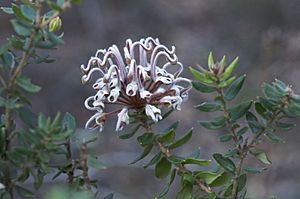Grey spider flower facts for kids
Quick facts for kids Grey spider flower |
|
|---|---|
 |
|
| Grevillea buxifolia photographed in Ku-rin-gai Chase National Park, Sydney | |
| Scientific classification | |
| Genus: |
Grevillea
|
| Species: |
buxifolia
|
Grevillea buxifolia, often called the grey spider flower, is a special plant. It belongs to the Proteaceae family, which includes many unique Australian plants. This plant grows naturally along the coast of New South Wales, Australia.
A scientist named James Edward Smith first described this plant in 1793. He originally gave it the name Embothrium buxifolium. Today, the grey spider flower is grown in many gardens. It has different types, called subspecies and cultivars, which mostly vary in how their beautiful flowers look.
Contents
What Does the Grey Spider Flower Look Like?
This plant usually grows as a small bush, about three to four feet (around 1 meter) tall. It has many branches covered in reddish or brown hairs. The branches are also packed with lots of leaves.
The Unique Flowers
The flowers of the grey spider flower are found at the ends of the branches. They are yellowish and white and hang down like little stars. These interesting flowers usually appear in November.
Each flower stands alone and points upwards. They grow on stalks that are covered in reddish-brown hairs. The main part of the flower is also hairy and forms a small cup-like shape. Inside, this part is white, and the petals are very pale or yellow. This lighter color spills out above the hairy sections.
The Leaves of the Plant
The leaves of the grey spider flower are oval-shaped and have clear veins. Their top surface is dark green and feels very rough. The edges of the leaves are smooth and roll slightly downwards. The underside of the leaves is soft and fuzzy.
The leaves grow directly from the stem, one after another, all along the branches. Each leaf ends in a small, sharp point.
Where Does it Grow?
The grey spider flower is native to the coastal areas of New South Wales, Australia. This means it naturally grows there and is an important part of the local environment.
See also
 In Spanish: Grevillea buxifolia para niños
In Spanish: Grevillea buxifolia para niños

